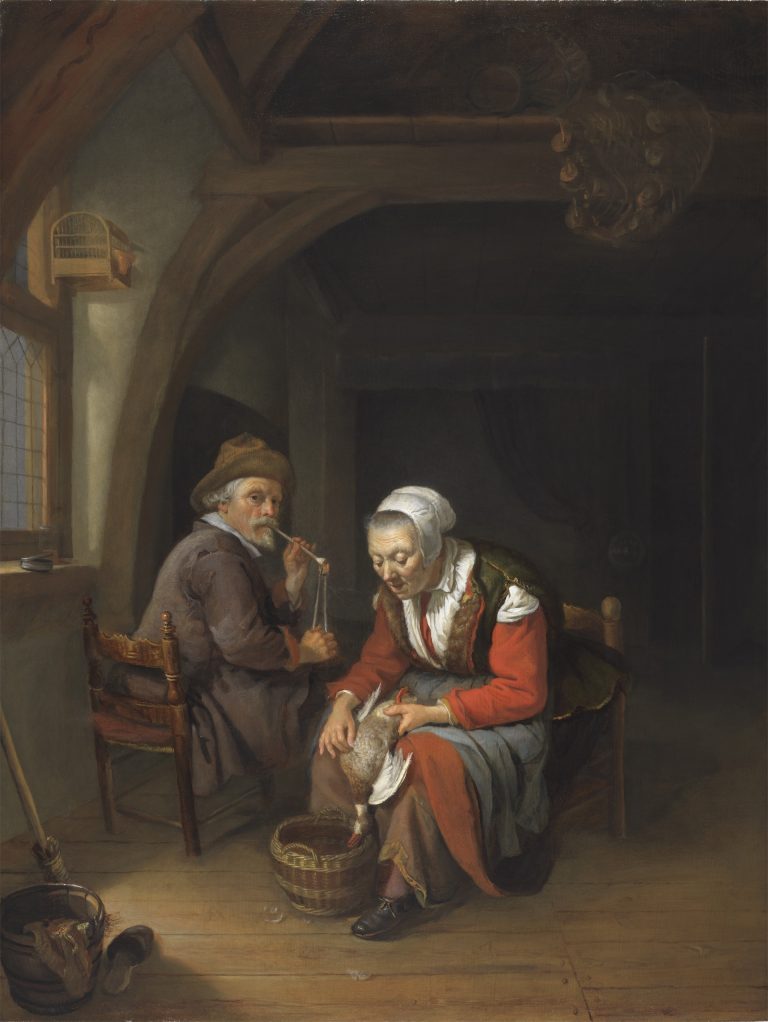Frans van Mieris the Elder’s fame rests largely on elegant paintings depicting the daily affairs of wealthy citizens (see Woman with a Lapdog, Accompanied by a Maidservant, FM-105; Woman Reading and a Man Seated at a Table, FM-107; and Young Woman Feeding a Parrot, FM-112), but he he began his career by representing the lower classes. This early work, datable to 1650–55, shows an elderly couple in a simple interior, the man lighting his pipe with a burning coal, the woman plucking a duck. The subject of women cleaning and preparing food for the family was often featured by Dutch artists from this period, particularly those from Leiden, as, for example, in a comparable scene from the mid-1650s by Abraham de Pape (before 1621–66) (fig 1).1 In Van Mieris’s painting, the man turns in his chair to look at the viewer, as though urging us to acknowledge the woman’s domestic virtue. She concentrates entirely on her task, and although she has endeavored to save the bird’s feathers in a wicker basket (the apparent cleanliness of the house is another example of her virtues as a housewife), some have fallen on the wooden floor in front of her.
Van Mieris depicted the elderly man lighting his pipe because this motif enhanced the realistic character of the scene: burning embers only glow in the bowl of the pipe when a smoker actually inhales. He adapted this motif from his teacher Gerrit Dou (1613–75), who included it at least twice in his paintings, once around 1635 when he depicted an elderly man lighting a pipe,2 and a second time around 1645, when he made an illusionistic painting in which an artist leans out of a window niche holding a lit pipe in his hand.3
Although Van Mieris was greatly influenced by Dou’s style and subject matter, he would quickly distinguish himself from his master. Even in his early paintings one can detect that Van Mieris, in the true spirit of aemulatio, strove to outdo his master in a number of ways. For example, around 1655 he began to paint with a luminosity unknown to his master, and he combined this heightened concern for the reflections of sunlight on objects with an increased precision in handling.4 Here, he has illuminated the protagonists with sunlight falling into the room through a leaded-glass window. Van Mieris silhouetted the figures against a background shrouded in darkness, where one can barely make out the curtain of a bed and a bed pan. In the foreground he grouped together a number of domestic items—a broom, a bucket, and a shoe—to create a repoussoir that helps establish a sense of spatial recession.
Van Mieris’s early works do not yet reveal the highly sophisticated palette of his later years, but they are not at all limited in color. In his early paintings he favored broad areas with strong local colors, among them vivid reds, blues and yellows. The rustic reds in one of Van Mieris’s signed paintings, A Peasant Meal, and the relatively unblended blues and yellows in Saying Grace (fig 2) are cases in point.5 The existence of such strong reds in Elderly Couple in an Interior is one basis for attributing this unsigned work to the young Van Mieris. Moreover, a number of objects in this painting are found in Van Mieris’s other early works, including a similarly designed birdcage placed before the window in A Peasant Meal and an identical chair in Saying Grace.6 Finally, the shape of the curved wooden beams in room’s interior are comparable to those in the latter work. It is striking that the iconography of these early works is uniformly positive.
When this painting was in the collection of the Barons Fisher, it was believed to be by the Leiden painter Abraham de Pape (before 1621–66).7 Later, in 1991, at a public sale in London, the painting was attributed to another Leiden artist, Dominicus van Tol (ca. 1635–76).8 The correct attribution to Van Mieris was made by Otto Naumann.9
